The 29 Best Trees for Wildlife
Are you looking for some great landscaping trees that also benefit wildlife? You can provide a welcoming environment in your yard and attract birds, butterflies, and other fascinating animals by planting wildlife-friendly tree species. In this article, gardening expert and wildlife biologist Liessa Bowen introduces 29 fantastic trees that will enhance your landscape and look great, too!
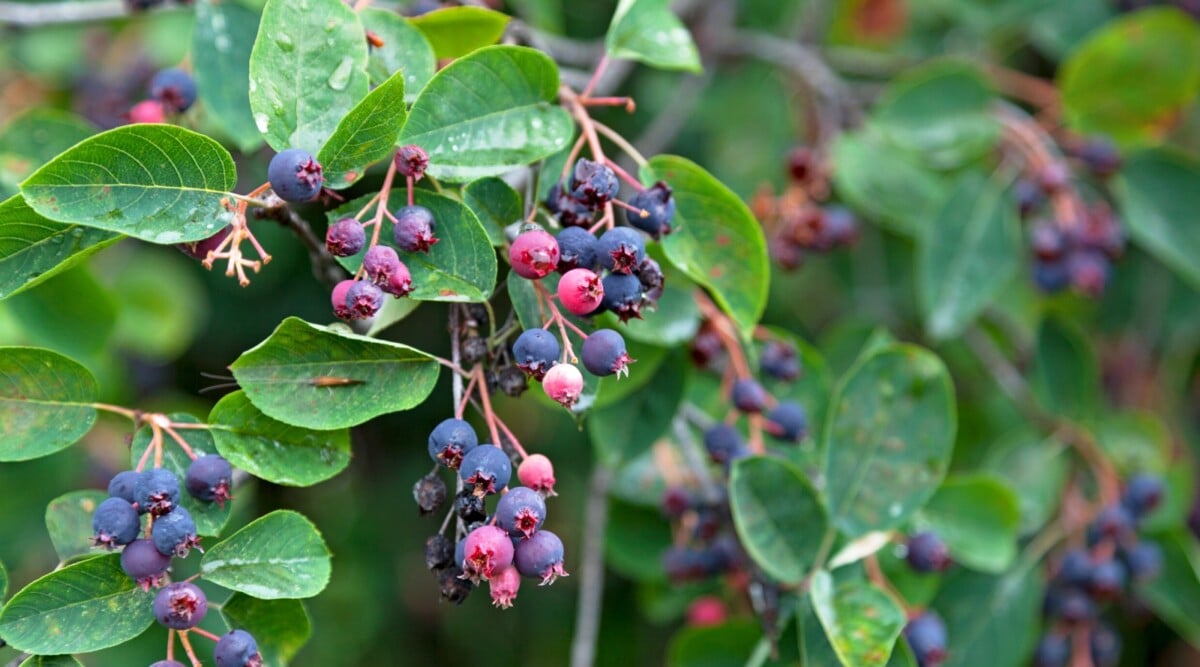
Contents
If you have space in your yard, consider planting a tree. They provide shade, structure, and year-round interest. They increase natural biodiversity as well as curb appeal for your home. Trees support clean air, provide oxygen, help clean water, and prevent soil erosion.
Animals need food, water, shelter, and a place to raise their young. Trees also offer valuable habitat for wildlife. Trees and shrubs can provide a direct source of food and foraging opportunities. Birds need trees for foraging fruits and flowers, hunting insect prey, nesting sites, protection from predators, and shelter. Beneficial insects use trees for shelter and sources of pollen and nectar. Butterflies and moths live on many trees as they are vital larval host plants. Mammals use trees as a source of food and shelter.
When you plant a tree, you not only welcome wildlife to your yard, you beautify your home environment. But you will want to choose the best tree, or trees, for your landscape. Check out the USDA Plant Hardiness Zones map to determine your zone and choose the best trees for your area. Then, make sure you match your chosen trees to your available growing conditions, including sunlight, soil type, and soil moisture.
There are trees for just about any landscape, as long as you have enough space. Are you ready to boost your backyard wildlife habitat? Keep reading to find out more about 29 terrific wildlife-friendly trees!
American Crabapple
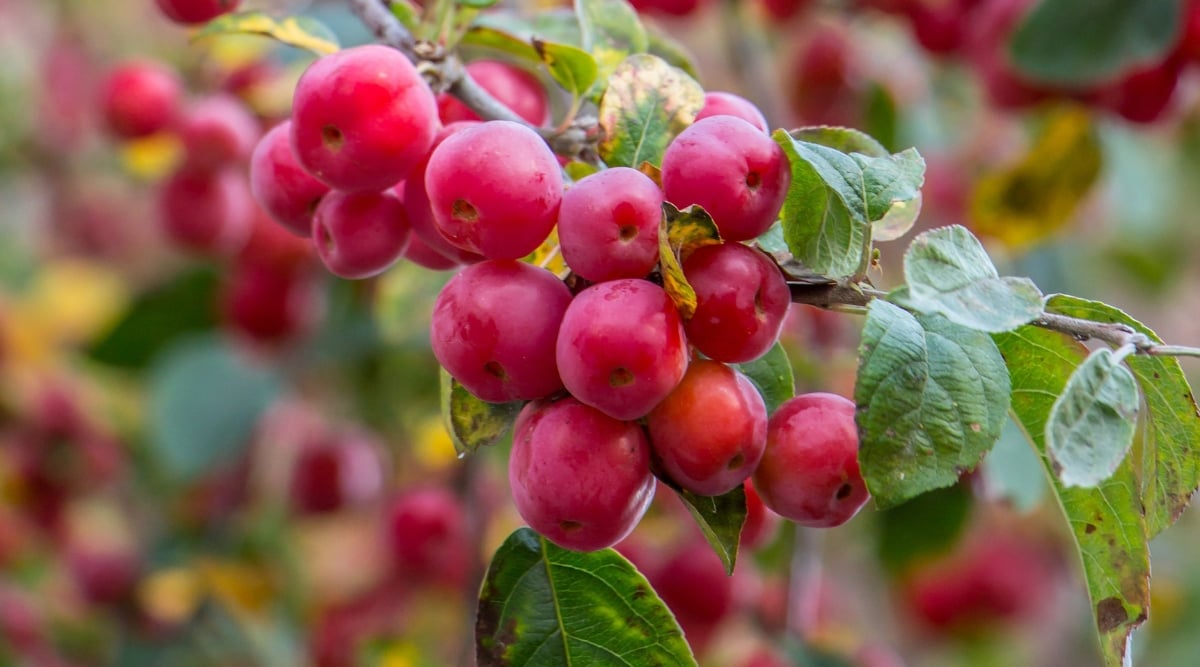
Cute crabapple trees provide an abundant amount of food and shelter for local wildlife.
|
|
botanical name Malus coronaria |
|---|---|
|
|
sun requirements Full sun to partial shade |
|
|
height 15 – 30 feet |
|
|
hardiness zones 4 – 8 |
The American crabapple is a small tree native to central and eastern North America. It prefers full sun but also does fine in light shade. Grow it with organically rich and consistently moist, well-drained soil. You can choose from numerous crabapple cultivars if this type isn’t available or doesn’t quite suit your specific needs.
American crabapple blooms in the springtime with abundant fragrant white or pink flowers. The flower nectar attracts plenty of pollinators and is a valuable food source for native bees.
The small fruits develop by mid-summer and are much loved by birds and small mammals, although humans find the crabapple fruits very bitter. A variety of wildlife will use crabapple trees for foraging, nesting, and shelter. You can make cider from yours if you choose.
American Holly

|
|
botanical name Ilex opaca |
|---|---|
|
|
sun requirements Full sun to partial shade |
|
|
height 40 – 60 feet |
|
|
hardiness zones 5 – 9 |
American holly is a familiar and easily recognized tree native to central and eastern North America. It is adaptable and easy to grow, tolerating a variety of light and soil conditions. Many varied cultivars are available, so you will find a holly that would be ideal for your landscape.
American holly has thick, shiny, evergreen leaves that are edged with sharp points. From spring into early summer, small, fragrant white flowers bloom in loose clusters and attract various pollinators. After flowering, very showy clusters of bright red fruits line the stems and attract lots of hungry birds.
Birds and other animals will use holly trees for shelter and foraging opportunities. American holly is also a larval host plant for the Henry’s Elfin butterfly.
Arrowwood Viburnum

|
|
botanical name Viburnum dentatum |
|---|---|
|
|
sun requirements Full sun to partial shade |
|
|
height 5 – 10 |
|
|
hardiness zones 2 – 8 |
The arrowwood viburnum is a small tree or large shrub native to central and eastern North America. It grows best in partial shade with rich, moist, well-drained soil. It will tolerate occasional drought and periodically wet soil conditions. These plants spread by root suckers, so go ahead and prune any new root sprouts you don’t want to reach maturity.
Arrowwood viburnum blooms in the spring with very dense clusters of tiny white flowers. The flowers are excellent for pollinators and will attract butterflies and bees. Following flowering, arrowwood viburnum develops loose groups of dark blue fruits that birds relish. The shrubby growth provides excellent shelter and foraging opportunities for birds and beneficial insects.
Black Cherry
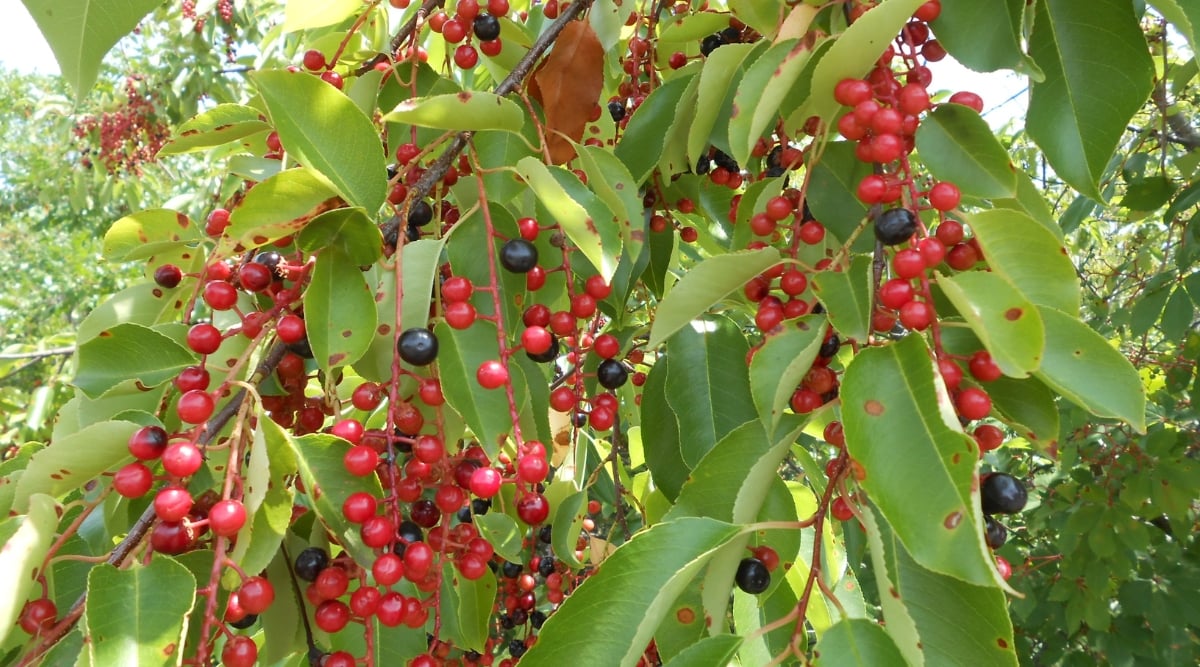
|
|
botanical name Prunus serotina |
|---|---|
|
|
sun requirements Full sun |
|
|
height 60 – 80 feet |
|
|
hardiness zones 2 – 8 |
This tall, deciduous tree is native to central and eastern North America. It grows primarily in cooler climate zones and doesn’t like extreme heat or humidity. It grows best in bright sun conditions but can also grow as an understory tree with adequate light. Give it a location with organically rich, moist, well-drained soil. Prune your black cherry low regularly to keep it shrub-sized, or allow it to grow naturally and reach its full height potential.
Black cherry blooms in the springtime with bright, fragrant white or pink blossoms. The flowers attract many pollinators, especially native bees. This tree is a larval host plant for several species of butterflies, including the eastern tiger swallowtail and the red-spotted purple butterfly.
The small, dark red fruits ripen in the summer and offer a valuable food source for fruit-eating birds and mammals. The edible fruits are bitter to humans but can be cooked and used to make jams and jellies.
Blackgum
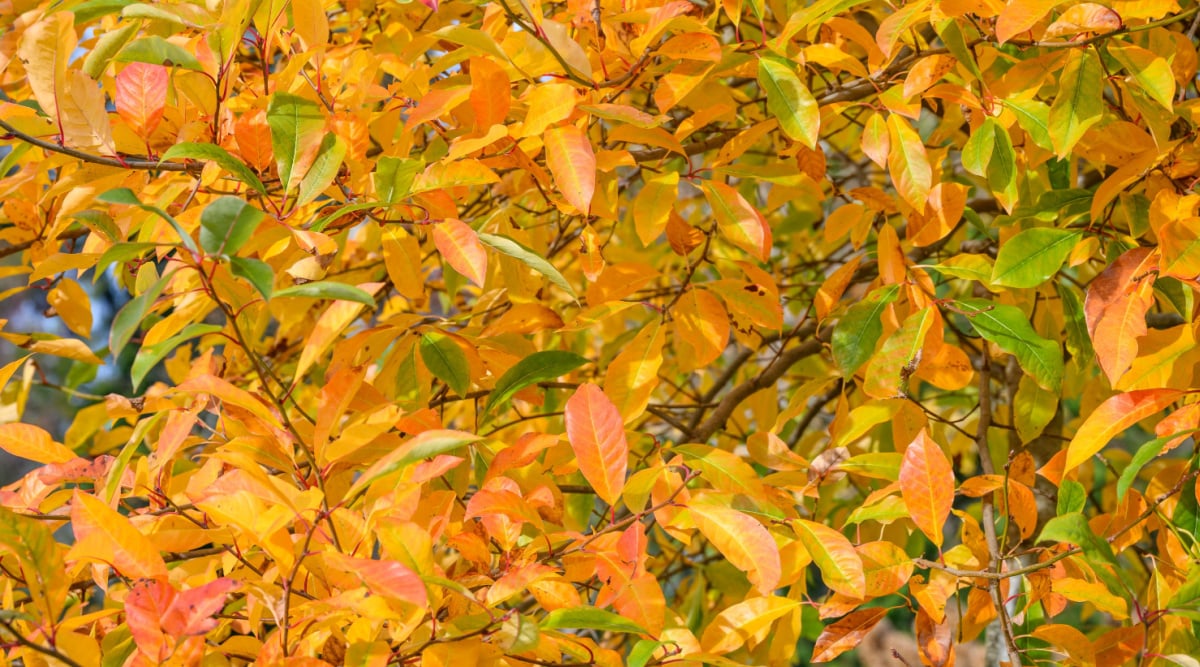
|
|
botanical name Nyssa sylvatica |
|---|---|
|
|
sun requirements Full sun |
|
|
height 40 – 70 feet |
|
|
hardiness zones 4 – 9 |
The black gum, also known as black tupelo, is an attractive medium-sized tree native to central and eastern North America. It is tolerant of various conditions, including dry forests and moist bottomlands. Although it prefers a sunny spot, it will also tolerate partial shade. Black gum trees are fairly slow-growing and make a beautiful landscaping plant.
Black gum has shiny oblong leaves and small greenish-white flowers that bloom in the spring and lure in honeybees. From mid-summer into fall, black gum produces small purplish-black fruits. These fruits provide an excellent food source for many birds and mammals, making this tree very valuable for wildlife.
From a landscape perspective, black gum also puts on a spectacular display of brilliant scarlet red fall foliage, making this a very desirable and ornamental tree.
Black Willow
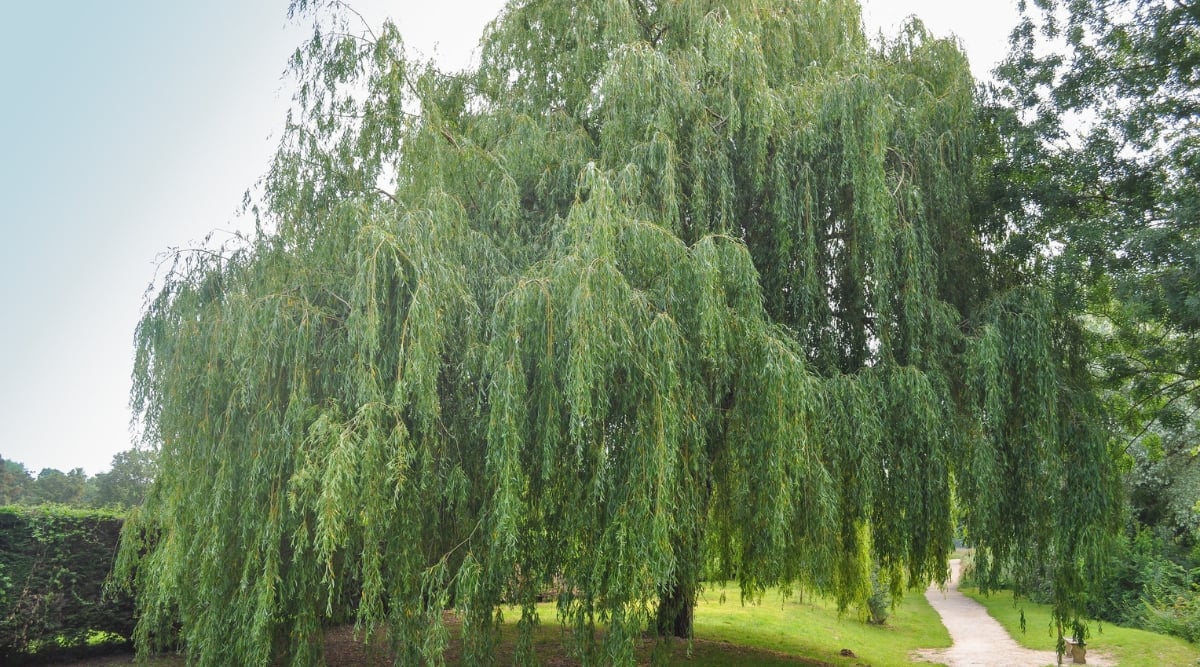
|
|
botanical name Salix nigra |
|---|---|
|
|
sun requirements Full sun to partial shade |
|
|
height 70 – 80 feet |
|
|
hardiness zones 4 – 9 |
The black willow is a large native of eastern and central North America. This tree typically grows in and around wetlands and areas with consistently moist soil. It is widespread and easy to grow but should be used primarily as a wetland tree or for erosion control rather than as a landscaping tree near your home. These trees have shallow, spreading root systems and brittle wood prone to breakage in high winds and ice or snow.
Black willow is a very useful wildlife tree, however. It is a larval host plant for several species of butterflies, including the eastern tiger swallowtail and the eastern comma butterfly. The small, inconspicuous flowers attract bees and foraging birds in the spring. The dense leafy branches provide excellent cover, nesting sites, and foraging opportunities for birds and other small animals.
Chickasaw Plum
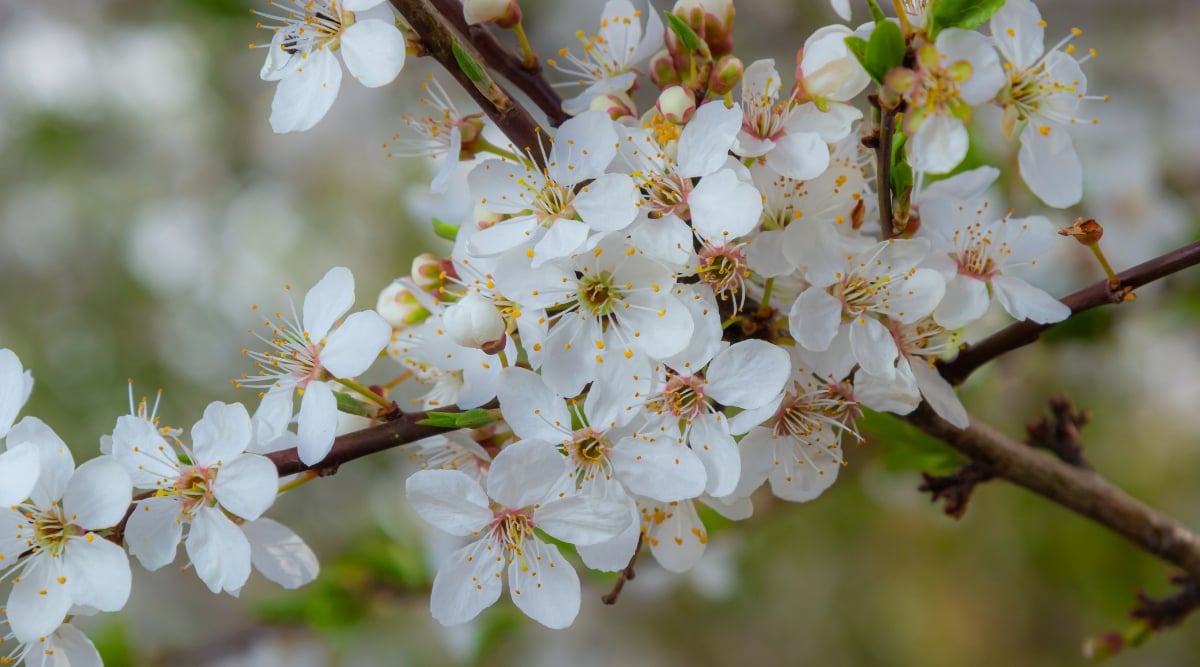
|
|
botanical name Prunus angustifolia |
|---|---|
|
|
sun requirements Full sun to partial shade |
|
|
height 4 – 15 feet |
|
|
hardiness zones 5 – 8 |
The Chickasaw plum is a small tree native to the southeastern United States. It adapts to many sun and soil conditions, making this an easy-to-grow tree. It spreads readily by root suckers, however, and any unwanted suckers should be removed promptly to prevent the formation of dense thickets. You can also choose to allow your Chickasaw plum to naturalize as a stream-side erosion control plant.
For wildlife, the Chickasaw plum offers many benefits. The small, white spring-blooming flower clusters attract pollinators, including native bees and butterflies. It is a larval host plant for several species of butterflies, including the coral hairstreak butterfly and the beautiful eastern tiger swallowtail.
The summer fruits are eaten by a variety of songbirds, larger ground-dwelling birds, and mammals. If allowed to spread on its own, a dense stand of plum trees provides excellent shelter for many wildlife species.
Chokecherry
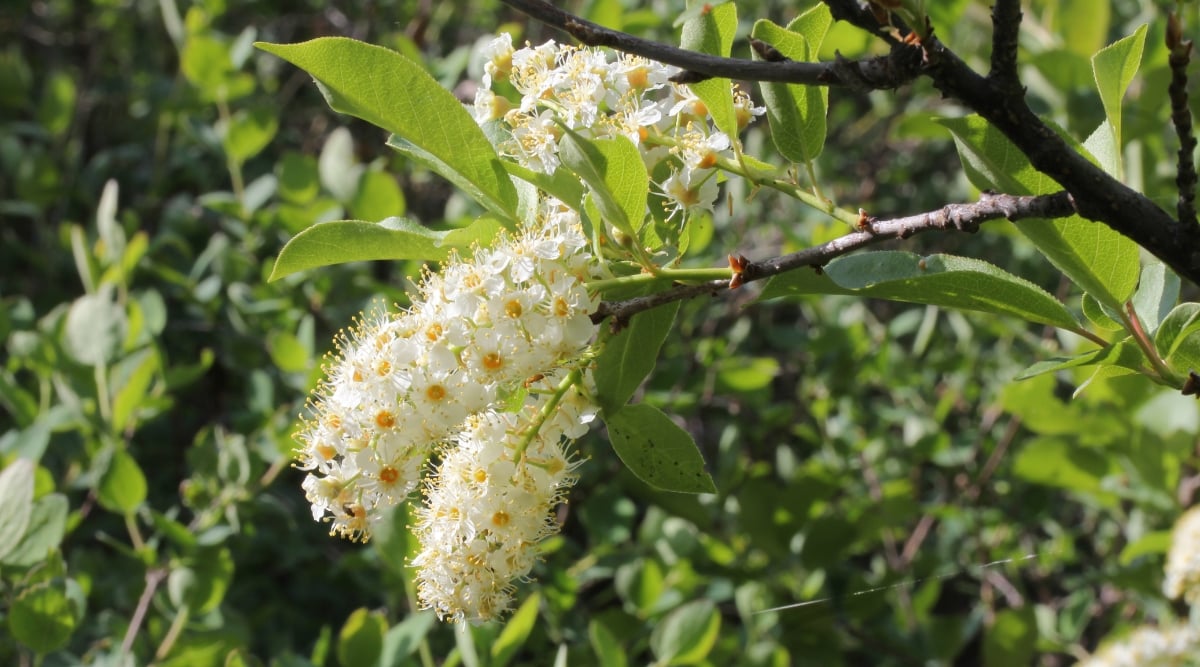
|
|
botanical name Prunus virginiana |
|---|---|
|
|
sun requirements Full sun |
|
|
height 20 – 30 feet |
|
|
hardiness zones 2 – 6 |
Chokecherry is a small tree native to the northern and northeastern United States and Canada. These trees form dense groupings in the wild by rapidly spreading root suckers. In a naturalized area, allow them to spread this way to form a thicket for wildlife or for erosion control. In a more cultivated setting, prune away unwanted root suckers to allow only a single upright stem.
Chokecherry gets its name from the very bitter fruits it produces. Animals, however, love the fruits. Birds and mammals happily eat them throughout the summer. In the spring, pollinators come to visit the fragrant white flowers. Chokecherry is also a larval host plant for the eastern tiger swallowtail butterfly. Birds and small mammals forage and seek shelter in the chokecherry branches and thickets.
Colorado Blue Spruce
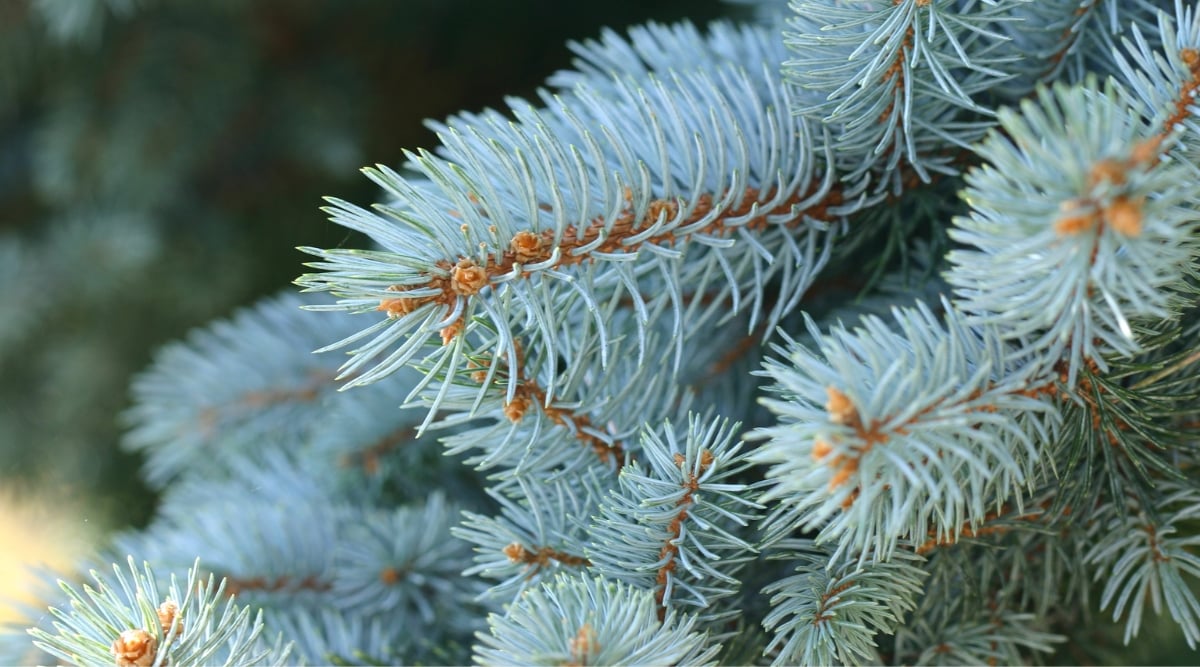
|
|
botanical name Picea pungens var. glauca |
|---|---|
|
|
sun requirements Full sun |
|
|
height 30 – 60 feet |
|
|
hardiness zones 2 – 3 |
The Colorado blue spruce is native to the Rocky Mountain region of the United States. It grows best in a cold mountain climate. The soil should be organically rich, acidic, and well-drained.
As long as you live in an area with ideal conditions, the Colorado blue spruce is an easy-to-grow and low-maintenance evergreen tree and makes a wonderful addition to your garden.
The Colorado blue spruce tree is a very attractive landscaping tree as well. It makes a substantial windbreak and offers a sense of privacy. Many birds use spruce trees for food and shelter. These trees also provide sheltering habitat for small mammals. Because they are evergreen, you and your resident wildlife can enjoy a Colorado blue spruce all year round.
Downy Serviceberry
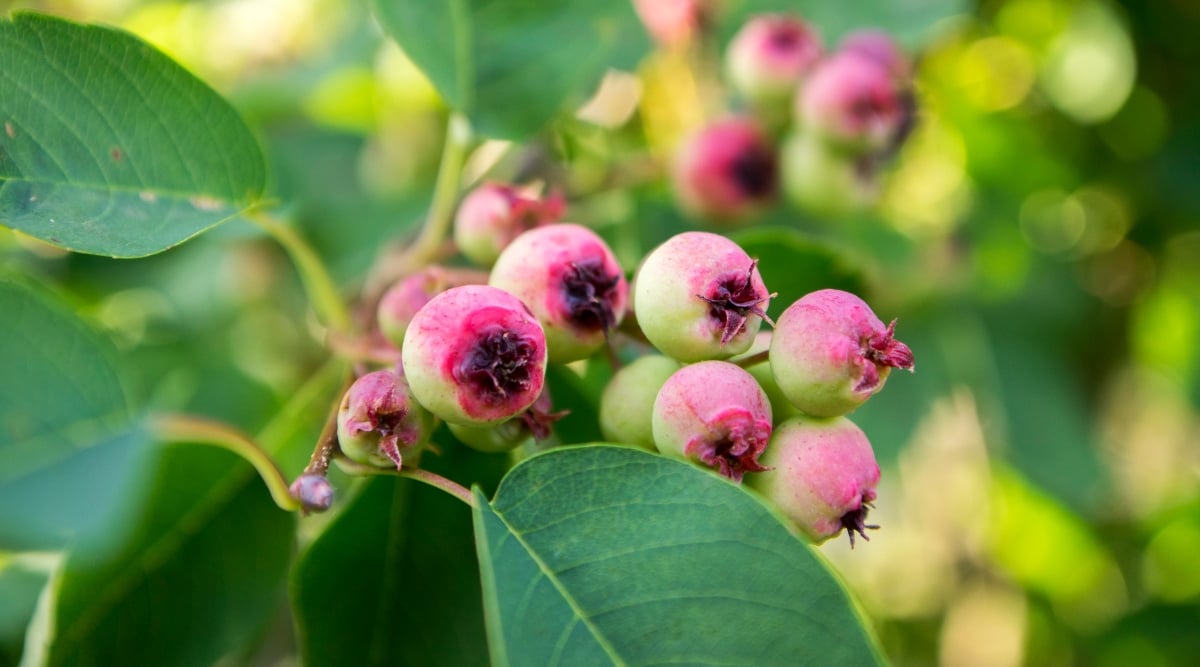
|
|
botanical name Amelanchier arborea |
|---|---|
|
|
sun requirements Full sun to partial shade |
|
|
height 15 – 25 feet |
|
|
hardiness zones 4 – 9 |
Downy serviceberry is a beautiful, small to medium-sized flowering tree native to eastern North America. It naturally grows in the understories of moist forests and open woodlands. In the home landscape, it prefers direct sun to light shade with moist, well-drained soil. Serviceberry trees tend to have a shrub-like form with several smaller branching trunks.
Downy serviceberry blooms in the spring. The masses of fragrant white flowers attract early-season pollinators. The edible fruits bring in hungry birds and small mammals. Humans can also enjoy serviceberries by cooking them into tasty pies and preserves.
Downy serviceberry is a larval host plant for the red-spotted purple butterfly and the viceroy butterfly. Birds use the branches to build nests and for additional perching and foraging opportunities.
Eastern Redbud
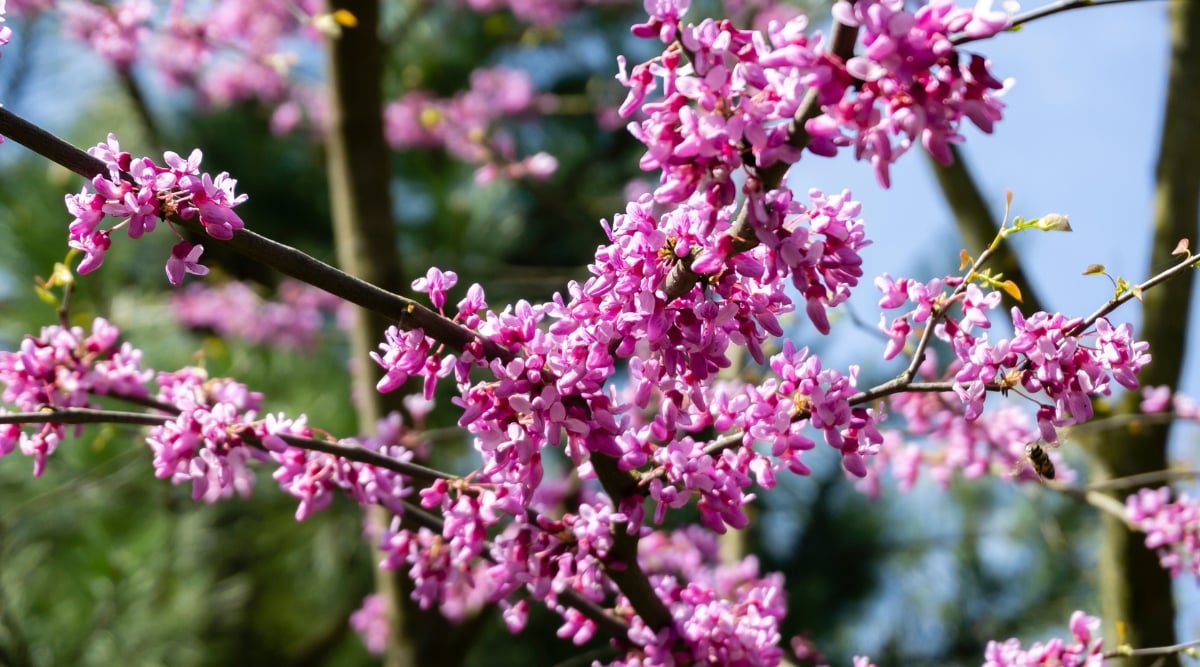
|
|
botanical name Cercis canadensis |
|---|---|
|
|
sun requirements Full sun to partial shade |
|
|
height 20 – 30 feet |
|
|
hardiness zones 4 – 9 |
The eastern redbud is a familiar sight each spring in the central and eastern United States. It is easily recognized by its abundance of pinkish-purple pea-like flowers that add early-season color to the landscape. It grows along roadsides, open woodlands, parks, and urban areas. This small tree prefers moist, well-drained soil and makes an excellent landscaping tree.
The eastern redbud is a valuable tree for wildlife. It is a larval host plant for several species of butterflies. Pollinators, including butterflies and bees, sip nectar from the brightly colored flowers.
Many birds use the branches for foraging, resting, and nesting. This is one of the earliest blooming flowering trees, making it a beautiful and welcome sight in early spring!
Eastern Redcedar

|
|
botanical name Juniperus virginiana |
|---|---|
|
|
sun requirements Full sun to partial shade |
|
|
height 30 – 40 feet |
|
|
hardiness zones 2 – 9 |
The eastern redcedar is an evergreen tree native to central and eastern North America. It isn’t a popular landscaping tree because of its somewhat coarse and messy appearance. These trees are easy to grow, however, and are a valued part of the natural ecosystem.
Eastern redcedar has short, bristly, scale-like leaves and typically grows in a characteristically pyramidal shape. It subsists in a wide variety of conditions. Eastern redcedar is a larval host plant for the juniper hairstreak butterfly and the imperial moth. Birds eat the small purplish-blue fruits and use these trees for their dense winter protective cover.
Eastern White Pine

|
|
botanical name Pinus strobus |
|---|---|
|
|
sun requirements Full sun to partial shade |
|
|
height 50 – 80 feet |
|
|
hardiness zones 3 – 8 |
The eastern white pine is a tall evergreen tree native to central and eastern North America. It typically grows in cooler climates with moist, well-drained soil. As a landscaping plant, give it plenty of space. A mature eastern white pine can grow 20 to 40 feet wide.
Pine trees are evergreen and make great year-round privacy or windbreaks. Animals also make good use of these trees during every season. Mammals eat the bark, twigs, and seeds of the eastern white pine.
Birds roost and seek cover in the dense branches and forage for insects in the bark. The eastern white pine is also a larval host plant for the imperial moth caterpillar.
Flowering Dogwood
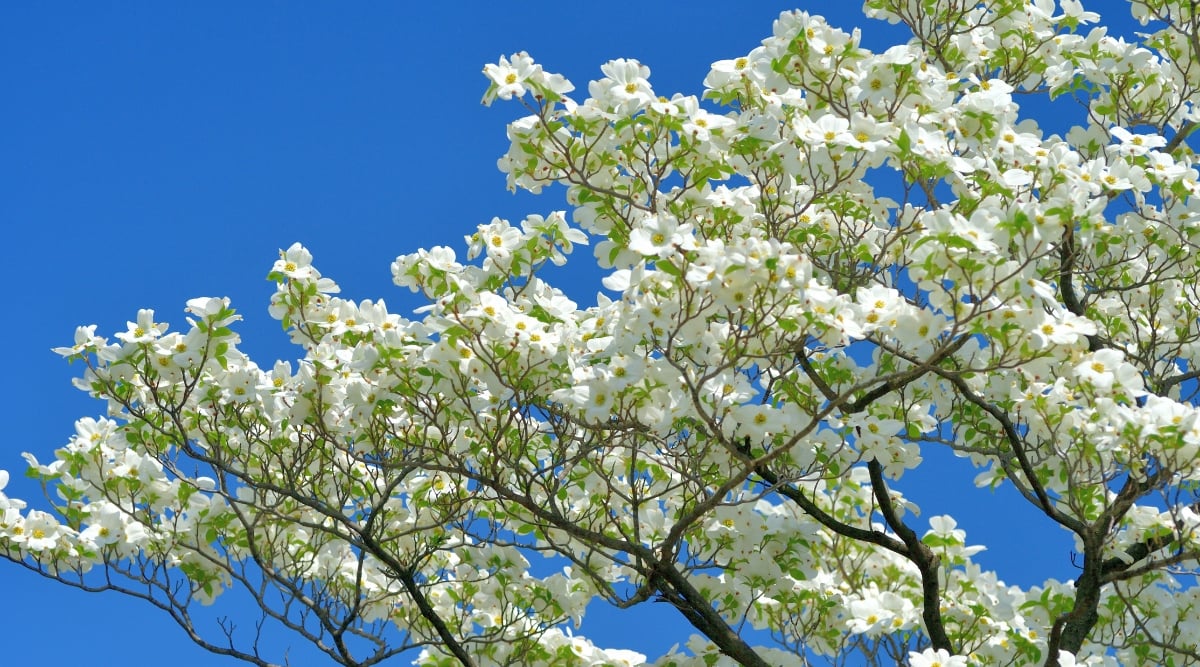
|
|
botanical name Cornus florida |
|---|---|
|
|
sun requirements Full sun to partial shade |
|
|
height 15 – 25 feet |
|
|
hardiness zones 5 – 9 |
The flowering dogwood is a beautiful and ornamental small native to central and eastern North America. It prefers organically rich, moist, well-drained soil and makes a very good landscaping tree. There are several beautiful dogwood cultivars available.
The flowering dogwood is a great addition if you are creating a wildlife-friendly landscape. It blooms in the springtime with extremely showy white to pink flowers that attract birds and many pollinators.
By late summer, these trees have scattered small red fruits that birds and mammals love to eat. The flowering dogwood is a larval host plant for the spring azure butterfly. Birds also use the branches for perching, nesting, and foraging for insects in the foliage.
Hackberry
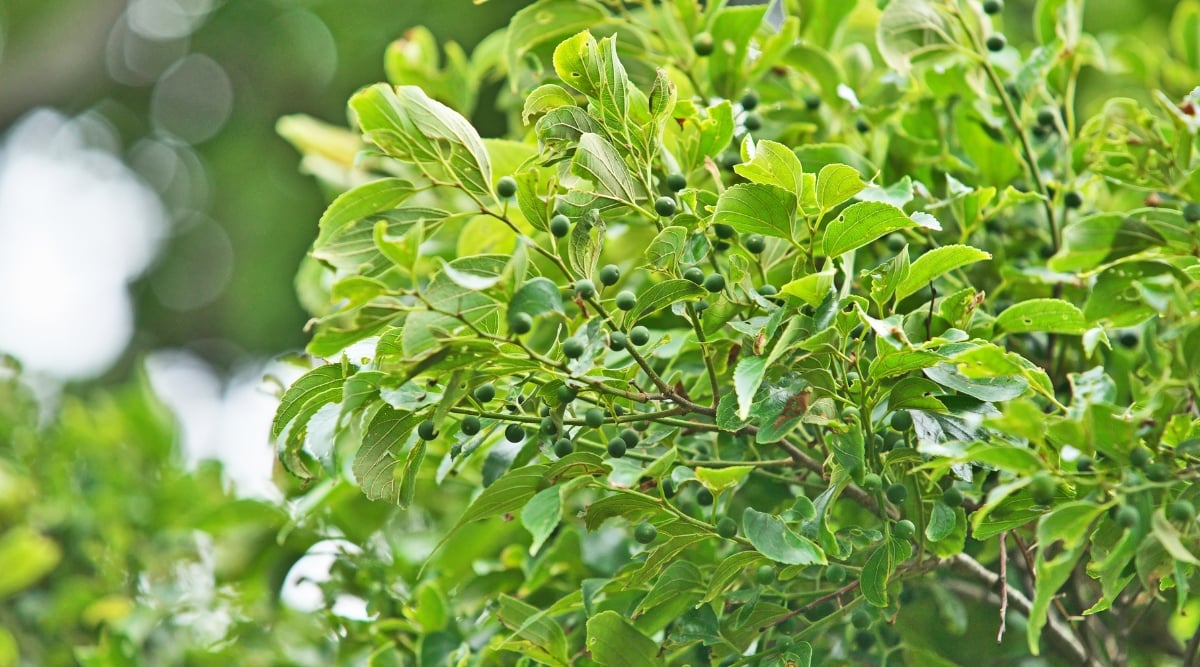
|
|
botanical name Celtis laevigata |
|---|---|
|
|
sun requirements Full sun to partial shade |
|
|
height 50 – 70 feet |
|
|
hardiness zones 5 – 10 |
Hackberry is a hardy and adaptable tree native to the central and southeastern United States and Mexico. It prefers rich, moist, well-drained soil but will tolerate various soil conditions. Also called sugarberry, this tree makes for good shade with interesting, uniquely thick, and corky-looking bark.
Hackberry is a valuable tree for wildlife. Birds forage along the bark to look for insects. It produces an abundance of small, round, red fruits in mid-summer, lingering into fall. Birds and mammals enjoy eating the fruits. Hackberry is an important larval host plant for several butterfly species, including the mourning cloak and the question mark butterfly.
Hawthorn
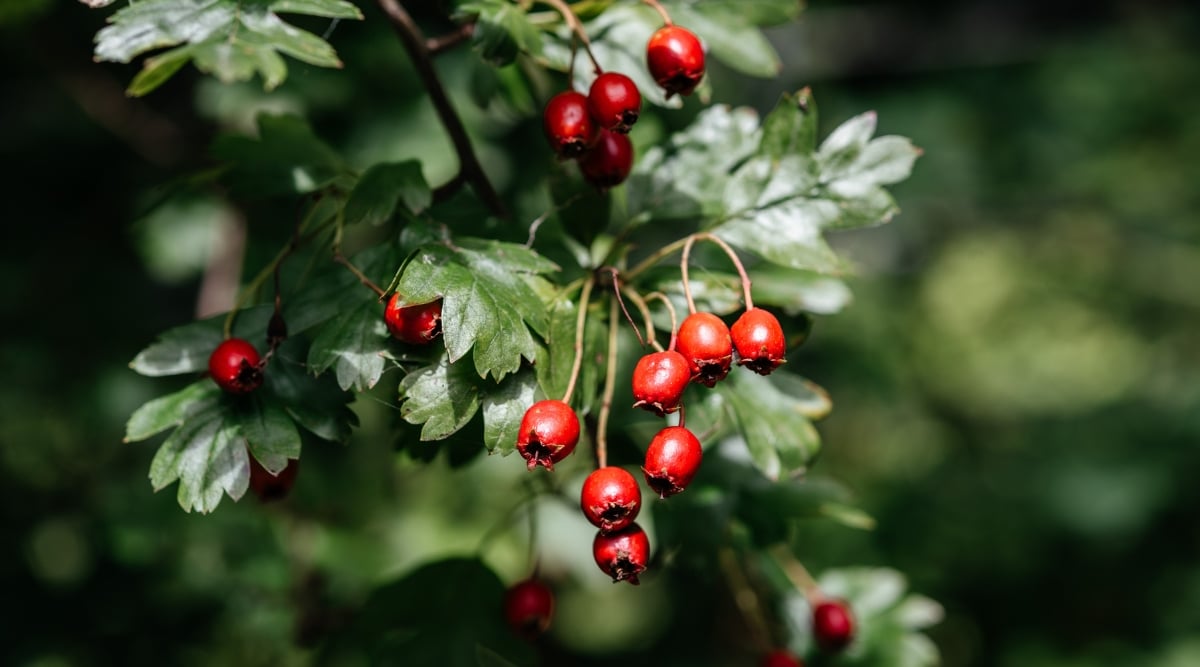
|
|
botanical name Crataegus aestivalis |
|---|---|
|
|
sun requirements Full sun to partial shade |
|
|
height 30 – 40 feet |
|
|
hardiness zones 6 – 11 |
This appealing small tree is native to the southeastern United States. It grows in moist woodlands and seasonal wetlands. For landscaping use, it is tolerant of a variety of conditions and grows well in both sunny locations and light shade. It prefers moist soil but is tolerant of varying soil conditions, too.
Hawthorn puts on a display with its spring-blooming white flowers. The flowers attract plenty of springtime pollinators, including native bees and butterflies. In mid to late summer, hawthorn fruits attract fruit-eating birds and mammals.
Hawthorn is a larval host plant for several species of butterflies, including the gray hairstreak, the red-spotted purple, and the viceroy butterfly. Allow hawthorn to grow naturally into a dense colony that offers abundant cover for wildlife, or prune off root suckers to train a single main trunk for a more tree-like appearance.
Hoptree
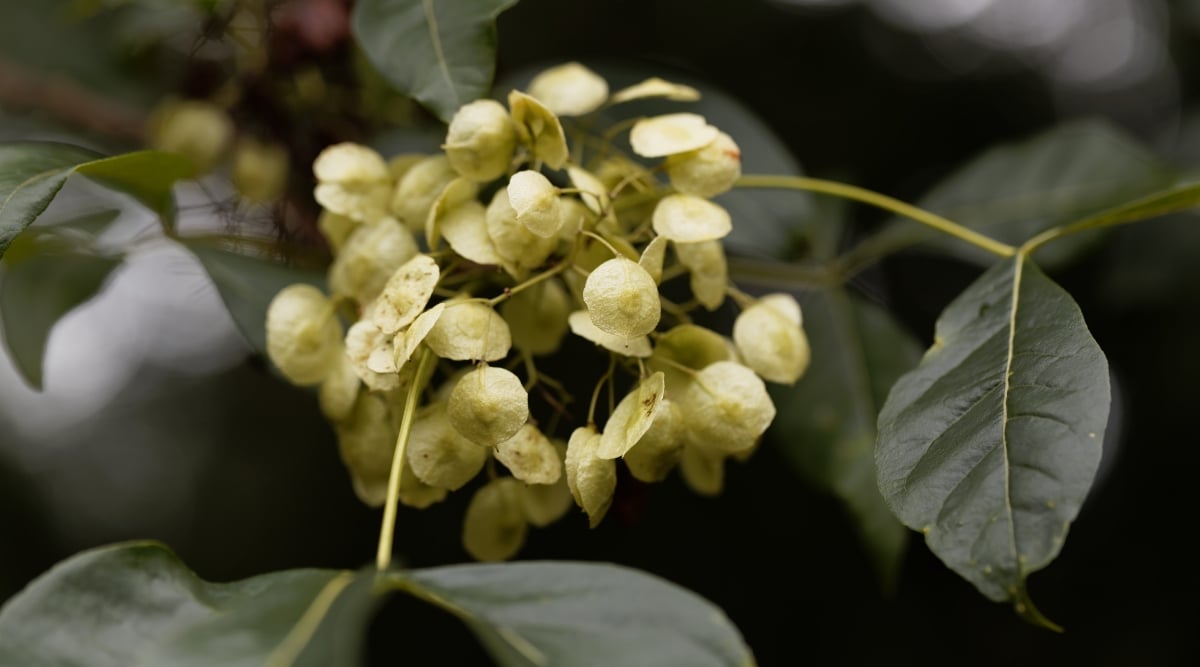
|
|
botanical name Ptelea trifoliata |
|---|---|
|
|
sun requirements Full sun to full shade |
|
|
height 10 – 20 feet |
|
|
hardiness zones 3 – 9 |
The hoptree is a small tree that is native to central and eastern North America. It is easy to grow and low maintenance. It naturally occurs as an understory tree and is quite tolerant of a shaded location. Give it moist, well-drained soil, and it should provide you with many years of enjoyment while providing some excellent wildlife habitat.
Hoptree blooms in the spring with lovely-looking but rather unpleasant-smelling flowers, so you might not want to grow it right outside your front door. Flowers give way to long-lasting clusters of papery-covered fruits that attract birds and other wildlife. These trees are also the larval host plant for the beautiful giant swallowtail butterfly. Birds will use hoptrees for nesting, foraging, and roosting.
Persimmon

|
|
botanical name Diospyros virginiana |
|---|---|
|
|
sun requirements Full sun to partial shade |
|
|
height 30 – 80 feet |
|
|
hardiness zones 4 – 9 |
The American persimmon is a fruit tree native to central and eastern North America. It makes a good understory tree or woodland edging, but can also handle plenty of sun. Give it a location with moist, well-drained soil.
There are several American persimmon cultivars available that are worthy of consideration. American persimmon fruits are highly astringent before they are fully ripe but become sweet and delicious after the first frost.
As a wildlife tree, the American persimmon is highly valued. The fruits provide plenty of nutrition for hungry birds and mammals. Deer browse the young leaves and twigs. Tree branches provide habitat, foraging, and nesting opportunities for birds. The American persimmon is also a larval host plant for the Luna moth and the hickory horned devil caterpillars.
Pignut Hickory

|
|
botanical name Carya glabra |
|---|---|
|
|
sun requirements Full sun to partial shade |
|
|
height 60 – 80 feet |
|
|
hardiness zones 4 – 9 |
The pignut hickory is a large tree native to central and southeastern North America. It’s a great shade tree. Give it rich, moist, well-drained soil, knowing it is adaptable to a variety of soil conditions. Your pignut hickory needs plenty of space for the crown to fill out completely and develop the best form.
Pignut hickory is a host plant for the banded hairstreak butterfly and the luna moth, as well as several other moth species. A wide assortment of large and small mammals eat the nuts that fall from the trees in the fall.
Birds use the trees for foraging, nesting, and shelter. These trees display attractive yellow-orange fall foliage, making them appealing landscape trees.
Quaking Aspen
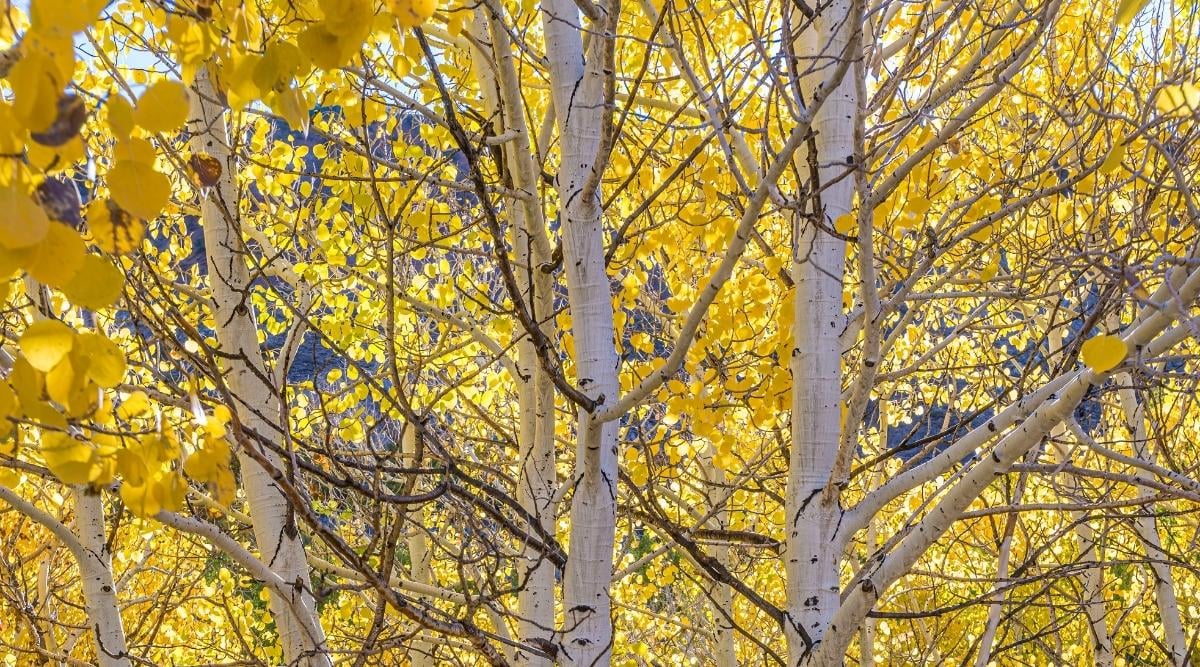
|
|
botanical name Populus tremuloides |
|---|---|
|
|
sun requirements Full sun |
|
|
height 40 – 50 feet |
|
|
hardiness zones 1 – 6 |
Quaking aspen is a showy medium-sized tree that’s native to the northern United States and Canada. Quaking aspens grow quickly but are relatively short-lived. They are very adaptable to a variety of sun and soil conditions, making them easy to cultivate in the appropriate cooler climate zones.
Quaking aspens make attractive landscaping trees with beautiful fall colors. These trees spread readily by rhizomes to form colonies. If you have an open space, let them spread out in an out-of-the-way location.
Many animals use quaking aspen trees. They are a larval host plant for the eastern tiger swallowtail butterfly and the viceroy butterfly. Birds and mammals eat the seeds, and because many aspen trees will grow close together, they provide excellent foraging habitat for birds.
Red Maple
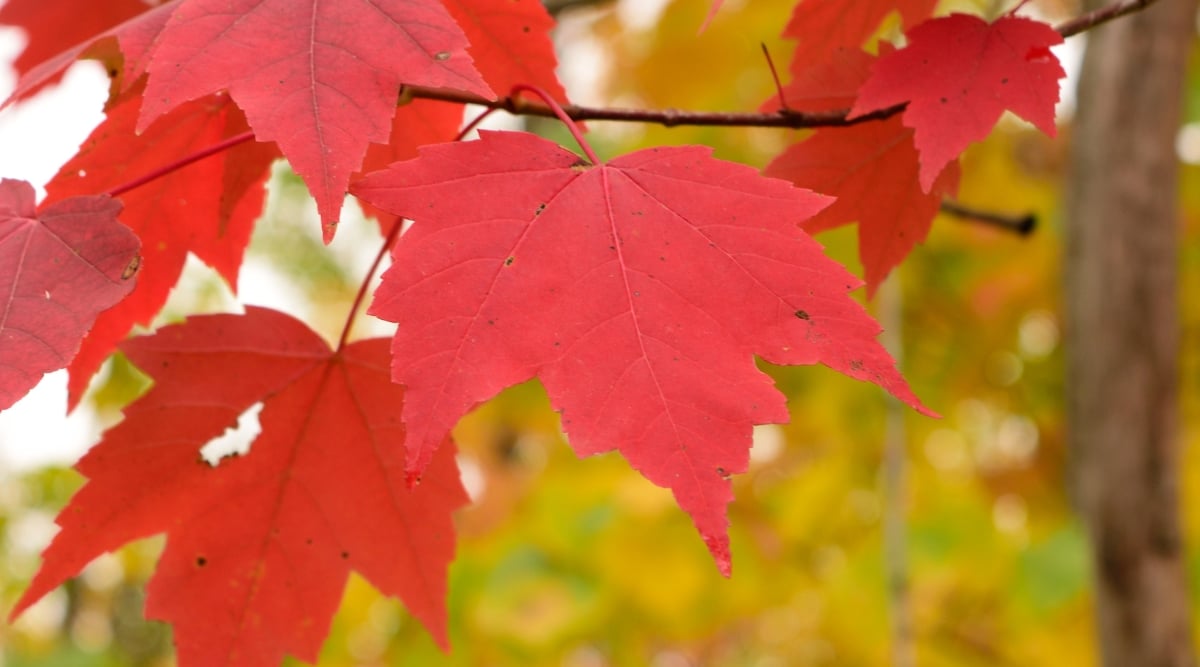
|
|
botanical name Acer rubrum |
|---|---|
|
|
sun requirements Full sun to partial shade |
|
|
height 40 – 120 feet |
|
|
hardiness zones 2 – 9 |
Red maple is a hardy and adaptable tree native to central and eastern North America. It grows naturally in a variety of forested habitats and is easy to incorporate into the home landscape. Grow it in a location with sun or partial shade and moist, well-drained soil. Red maple easily tolerates periodically wet and dry soil conditions.
Red maple trees bloom in the early spring. The flowers are small but attractive, forming in yellowish-orange bunches before the trees leaf out for the summer. The flowers will attract pollinators, birds, and squirrels looking for a source of food. The seeds are also eaten by birds and mammals.
Red maple is a larval host plant for the imperial moth. Birds use the trees for foraging, nesting, and roosting. Red maples are also well appreciated for their spectacular fall foliage.
Scarlet Oak
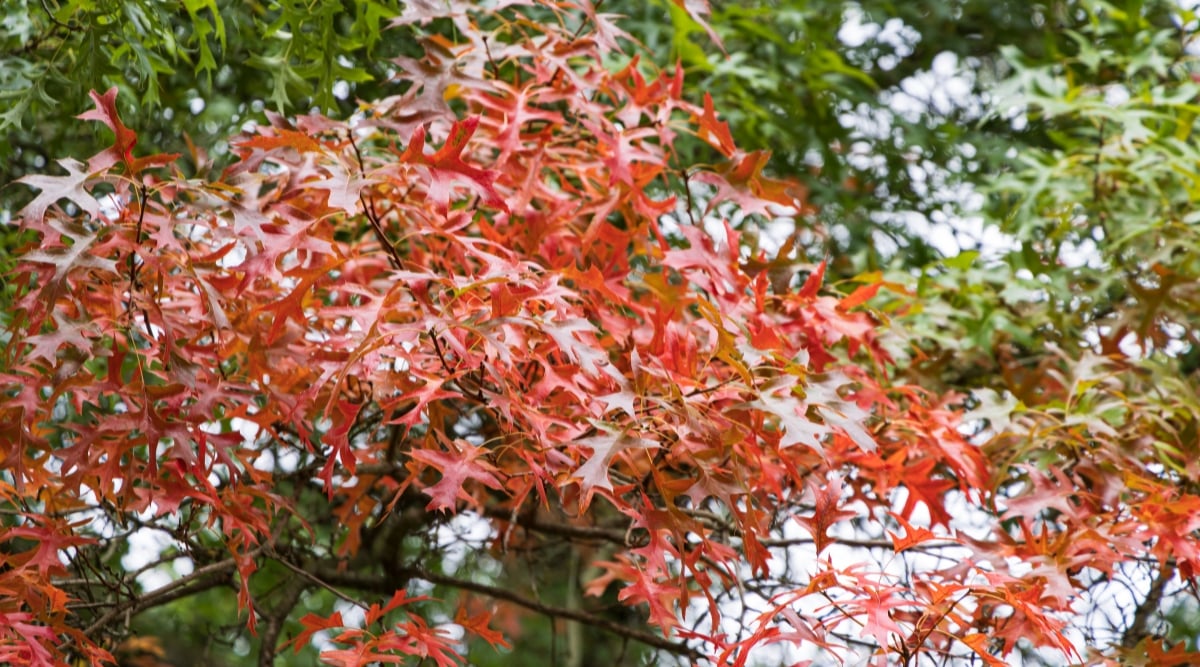
|
|
botanical name Quercus coccinea |
|---|---|
|
|
sun requirements Full sun to partial shade |
|
|
height 50 – 80 feet |
|
|
hardiness zones 4 – 9 |
The scarlet oak (also called the black oak) is a large tree native to eastern North America. Give your scarlet oak plenty of room to grow, because this makes a spectacular large shade tree, especially when the crown is not crowded by neighboring trees.
Scarlet oak also makes a very useful tree for wildlife. Mature trees develop acorns, which are an important food source for many species of mammals as well as some birds. Birds will primarily use the scarlet oak as an opportunity to forage for insects, build nests, and seek shelter.
Oaks are a larval host plant for many various species of butterflies and moths. In the fall, the scarlet oak puts on a showy display of dark scarlet-red foliage.
Sugar Maple
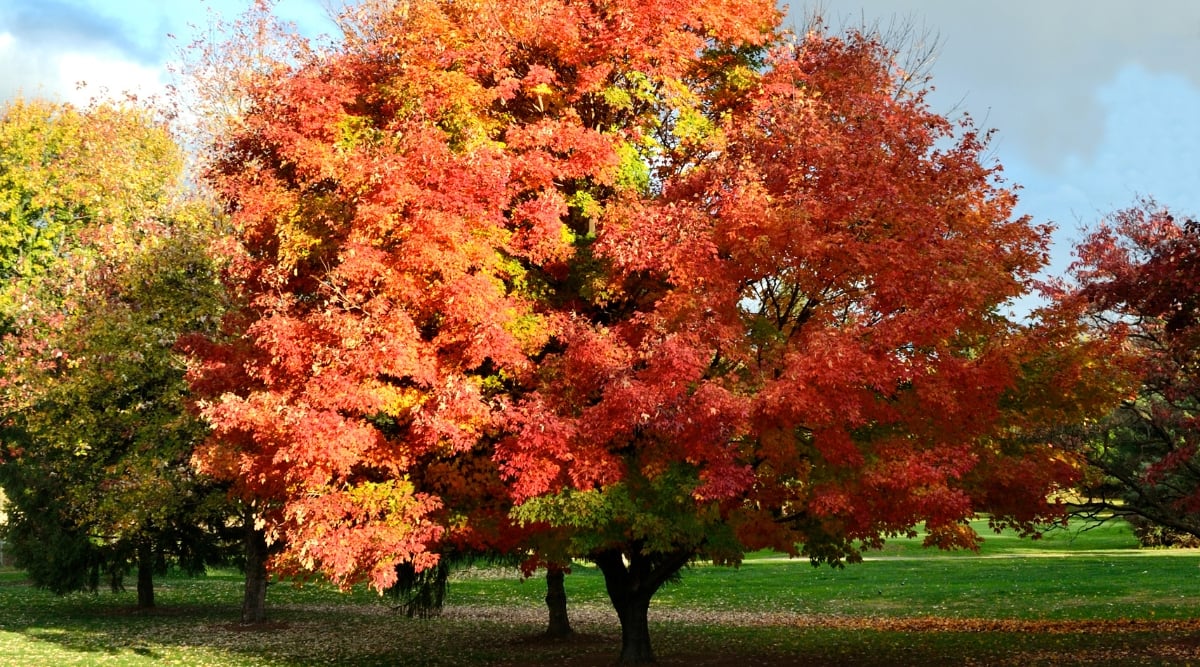
|
|
botanical name Acer saccharum |
|---|---|
|
|
sun requirements Full sun |
|
|
height 40 – 120 feet |
|
|
hardiness zones 3 – 8 |
The sugar maple is a medium to large-sized tree native to the cooler regions of central and eastern North America. It grows best in rich, moist, well-drained soil. This tree is easily recognized in the fall as one of the premier fall foliage trees in New England and the Upper Midwest.
Sugar maple makes a wonderful shade tree that benefits both people and wildlife. Birds, pollinators, and small mammals feed on the spring-blooming flowers. Birds and mammals come back again and again to forage on the seeds.
Maples provide plenty of nesting and foraging opportunities for birds and other animals. People enjoy the spectacular fall foliage and use the trees to make maple syrup.
Sweet Bay Magnolia

|
|
botanical name Magnolia virginiana |
|---|---|
|
|
sun requirements Full sun to partial shade |
|
|
height 10 – 35 feet |
|
|
hardiness zones 5 – 10 |
The sweet bay magnolia is a lovely evergreen or semi-evergreen tree native to the southeastern United States. In its native habitat, it grows in moist woodlands. For the home landscape, grow it in rich, moist, or boggy soil. In the warmer parts of its range, the leaves remain evergreen, making this a good tree for a privacy hedge.
Sweet bay magnolia has showy white flowers that bloom in the spring. The flowers attract pollinators. The fruits and seeds are eaten by birds and small mammals. Sweet bay magnolia is a larval host plant for the spicebush swallowtail butterfly and the eastern tiger swallowtail butterfly.
Because these trees are evergreen to semi-evergreen, they provide excellent winter cover and foraging opportunities for winter birds and small mammals.
Washington Hawthorn
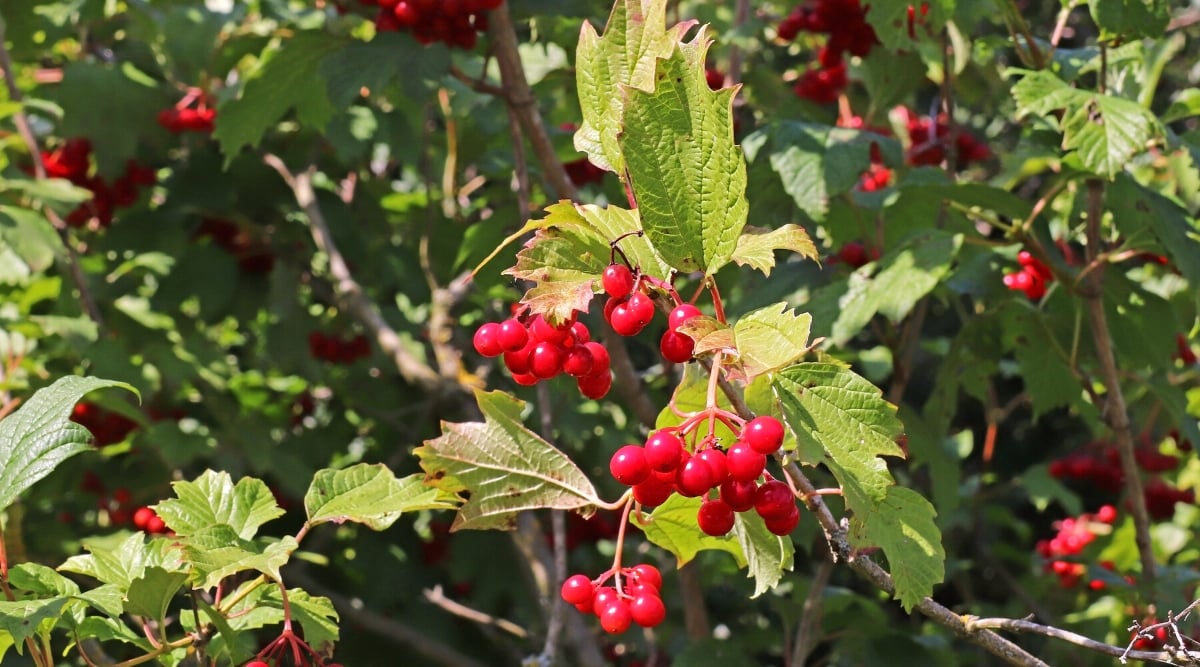
|
|
botanical name Crataegus phaenopyrum |
|---|---|
|
|
sun requirements Full sun to partial shade |
|
|
height 25 – 30 feet |
|
|
hardiness zones 4 – 8 |
The Washington hawthorn is a medium-sized tree native to southeastern North America. This plant grows best in full sun or light shade with rich, moist, well-drained soil. It has a dense, many-branched form and spiny stems, and it makes a good tree for a privacy hedge.
Washington hawthorn blooms in late spring with clusters of beautiful, fragrant white flowers. The flowers attract pollinators, especially native bees and butterflies. They give way to clusters of bright red fruits that birds love to forage.
Washington hawthorn is the larval host plant for several species of butterflies, including the gray hairstreak and the viceroy. The trees also provide plenty of nesting opportunities, cover, and foraging opportunities for birds.
White Oak
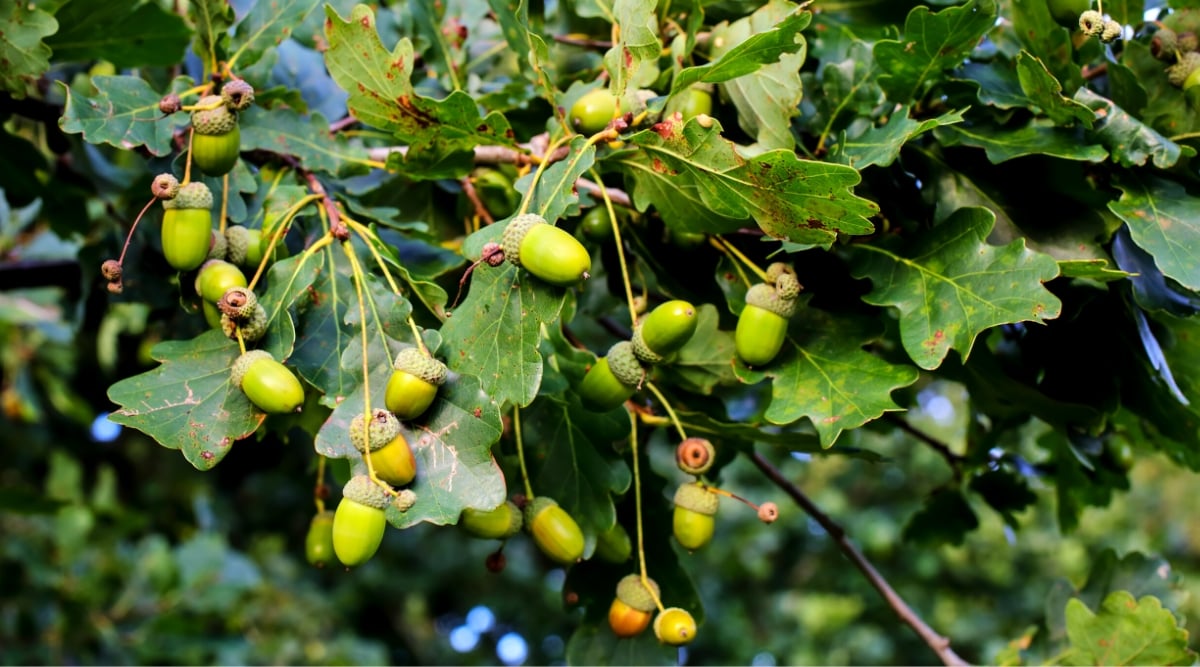
|
|
botanical name Quercus alba |
|---|---|
|
|
sun requirements Full sun |
|
|
height 50 – 135 feet |
|
|
hardiness zones 3 – 9 |
White oak is a large shade tree native to central and eastern North America. This tree is easy to grow and a very valuable forestry and wildlife tree. It thrives in full sun but tolerates light shade. Give it a location with moist, well-drained soil and plenty of space for it to spread to a full crown size of 50 to 80 feet across.
White oak is the larval host plant for several species of butterflies and moths. Other insects also feed on the leaves, which makes this an excellent tree for migratory songbirds to use while foraging for food.
The acorns ripen in the fall and provide yet another source of food for some larger bird species, as well as numerous mammals. White oaks attract many species of birds for nesting sites and shelter from inclement weather. The white oak has attractive yet subtle fall foliage in shades of purplish to reddish-brown.
Winterberry Holly
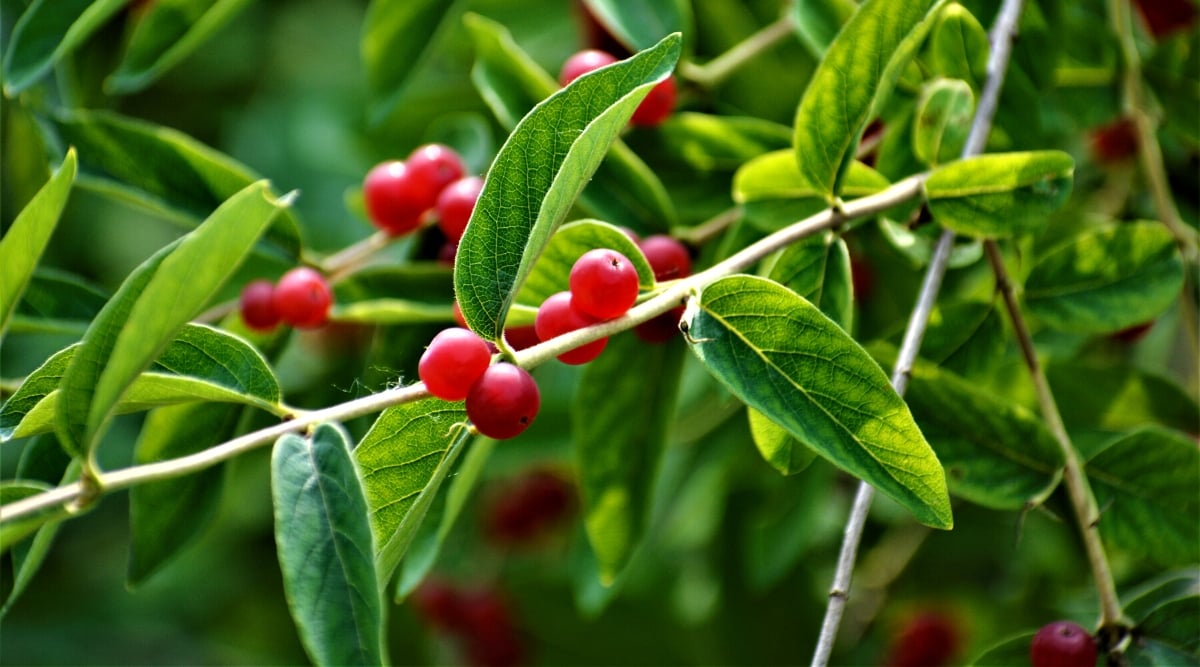
|
|
botanical name Ilex verticillata |
|---|---|
|
|
sun requirements Full sun to full shade |
|
|
height 5 – 15 feet |
|
|
hardiness zones 3 – 9 |
Winterberry holly is a small tree or shrub native to eastern North America. It is tolerant of a range of sun conditions, from very sunny to heavy shade. It prefers moist to occasionally wet, well-drained, acidic soil with a pH of less than 6.0. This tree makes a great hedge plant and is very easy to grow, though it takes its time.
Winterberry holly blooms in the spring with small, showy, greenish-white flowers that attract pollinators. The clusters of very showy, bright red fruits ripen in the fall and persist well into the winter months. The fruits attract many species of birds as a valuable source of cold-weather nutrition.
Winterberry holly is also the larval host plant for the Henry’s elfin butterfly. Plenty of birds, beneficial insects, and small mammals will use the winterberry holly for not only food but also shelter and nesting sites.
Yellow Birch
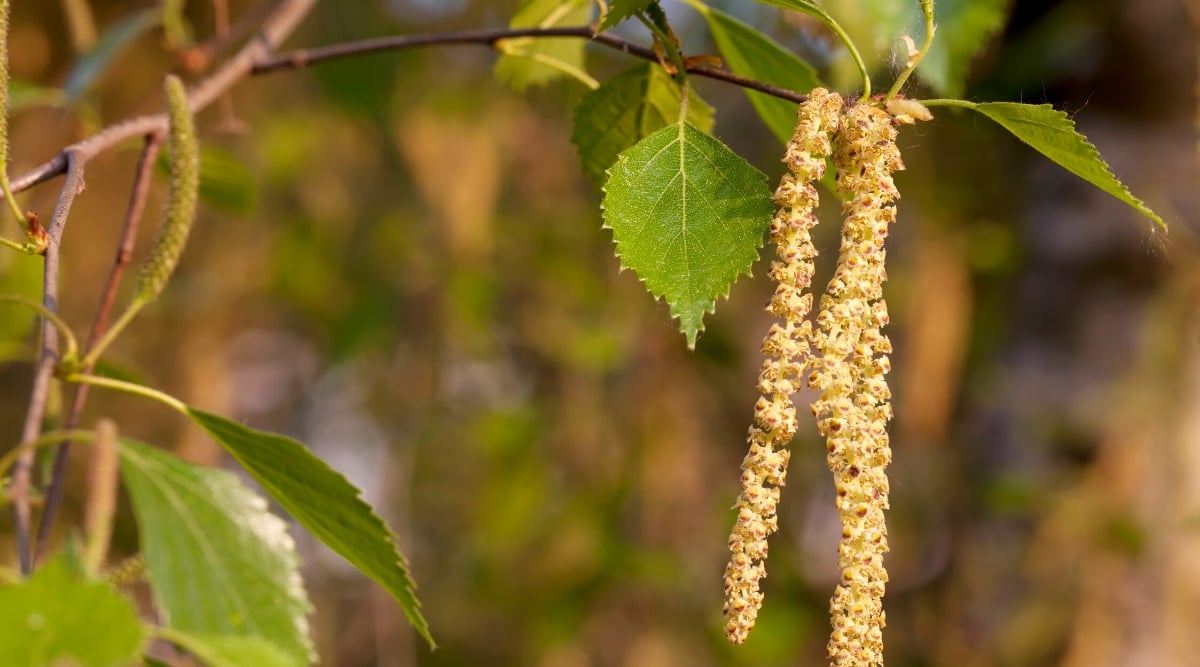
|
|
botanical name Betula alleghaniensis |
|---|---|
|
|
sun requirements Full sun to partial shade |
|
|
height 70 – 80 feet |
|
|
hardiness zones 3 – 7 |
The yellow birch is a large tree that is native to the northeastern United States and eastern Canada. It is best grown in cooler climates. Soil should be moist and well-drained. In its natural habitat, this is primarily a forest tree that prefers higher elevations and doesn’t like heat and humidity.
Yellow birch is a great wildlife tree. It is a larval host plant for several species of butterflies and moths, including the mourning cloak butterfly and the dreamy duskywing butterfly.
Birds forage for insects in the foliage and use the trees for nesting sites and shelter. Both birds and small mammals use the birch bark as nesting material.
Yellow Poplar
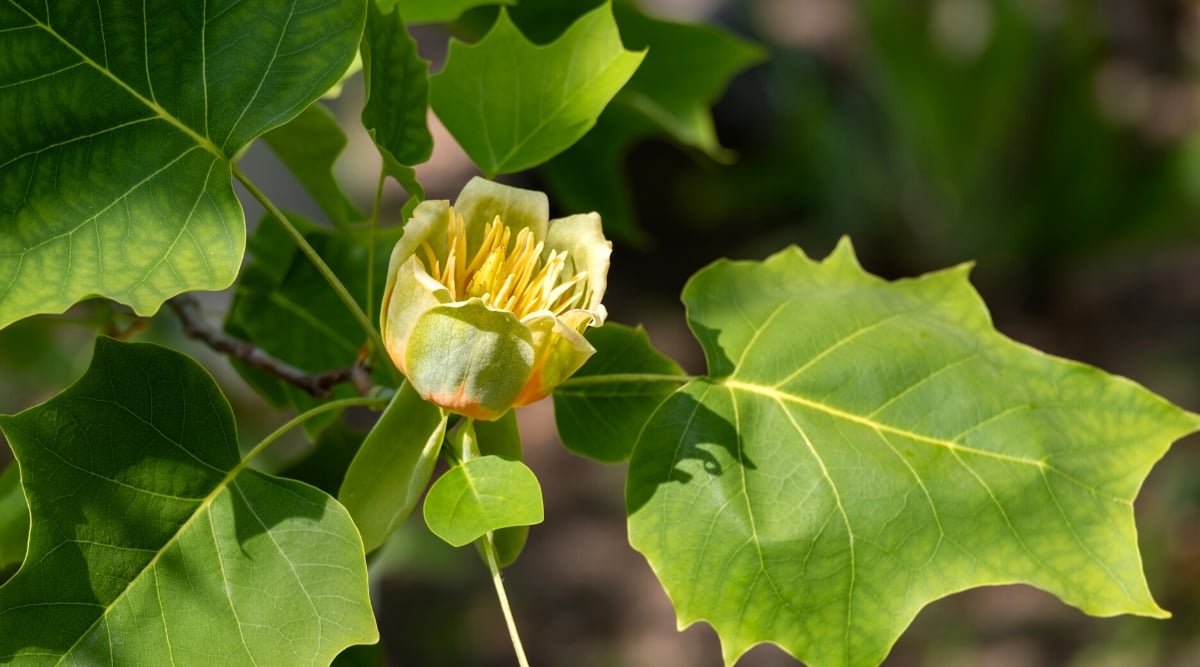
|
|
botanical name Liriodendron tulipifera |
|---|---|
|
|
sun requirements Full sun |
|
|
height 80-120 feet |
|
|
hardiness zones 4 – 9 |
The yellow poplar is a large tree native to central and eastern North America. It is a fast-growing and fairly common tree in many natural woodland habitats. In your home landscape, give it a location with moist, well-drained soil.
Yellow poplar has large, interesting flowers that bloom in late spring. The flowers attract a wide variety of birds and pollinators. Deer and squirrels eat the buds and seeds. Yellow poplar is a larval host plant for several species of butterflies, including the eastern tiger swallowtail and the spicebush swallowtail butterfly. Birds and mammals use these trees for nesting and foraging, as well as shelter and protection.
Frequently Asked Questions
When is the best time to plant trees?
You can plant new trees in your landscape in the early spring or late fall. Ideally, do your transplanting when the tree is dormant or partially dormant to minimize stress. If you buy trees from online nurseries, they may ship bareroot live trees during the ideal planting times and you should be prepared to transplant your new plants as soon as you receive them. Generally, it’s best to avoid planting in mid-summer.
Are there any types of trees I shouldn’t plant?
The best and most beneficial trees you can plant will be species native to your region. You can also safely plant tree species native to other nearby areas as long as they grow in your climate. Don’t grow invasive species in your yard, however. Invasive species, such as the Bradford pear, provide very little value for wildlife and quickly become a nuisance because they spread freely and are very difficult to eradicate once they become established.
How fast do trees grow?
Different trees grow at very different rates. Fast-growing trees and shrubs grow more than 24 inches per year and reach a mature size quickly. Slow-growing trees may grow less than 12 inches annually and take many years to reach maturity. Any tree you plant, however, provides beauty, interest, and wildlife habitat, even when it is young and small.
Final Thoughts
Trees make a beautiful and valuable addition to your landscape. If you have the space for a tree, they really have a lot to offer, including shade, plenty of curb appeal, spring flowers, fall foliage, and year-round structure and diversity. Many animals, from birds to bears and plenty of pollinators, use trees for food, shelter, and building homes.
Trees also provide other environmental services, including clean air, clean water, erosion control, and intrinsic beauty. So what are you waiting for? Plant a tree and create or improve habitat for your local wildlife.







